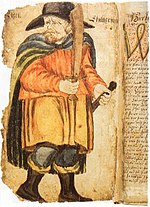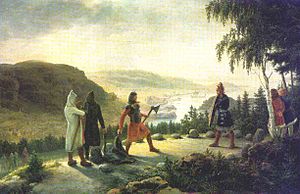
Picture of Egil in a 17th-century manuscript of Egils Saga
Egill Skallagrímsson also known as Egil Skallagrimsson[1] (c. 910 – c. 990)[2] was a Viking Age poet, warrior and farmer.[1] He is also the protagonist of the eponymous Egil's Saga. Egil's Saga historically narrates a period from approximately 850-1000 CE, being written somewhere between 1220 and 1240.[1]
Life[]
- The following is based on the Icelandic saga "Egils saga"; like many sagas, it can be unreliable as a source of historical fact.

Egill engaging in holmgang with Berg-Önundr; painting by Johannes Flintoe.
Egill was born in Iceland, the son of Skalla-Grímr Kveldúlfsson[3] and Bera Yngvarsdóttir, and the grandson of Kveld-Úlfr ("Evening Wolf"). When Grímr arrived in Iceland, he settled at Borg, the place where his father's coffin landed. Grímr was a respected chieftain and mortal enemy of King Harald Fairhair of Norway.
Egill composed his first poem at the age of three years. He exhibited berserk behaviour, and this, together with the description of his large and unattractive head, has led to the theory that he might have suffered from Paget's disease. At the age of seven, Egill was cheated in a game with local boys. Enraged, he went home and procured an axe, and returning to the boys, split the skull of the boy who cheated him, to the teeth. After Berg-Önundr refused to allow Egill to claim his wife Ásgerðr's share of her father's inheritance, he challenged Önundr to a holmgang.
Later, after being grievously insulted, Egill killed Bárðr of Atley, a retainer of King Eirik Bloodaxe and kinsman of Queen Gunnhildr, both of whom spent the remainder of their lives trying to take vengeance. Seething with hatred, Gunnhildr ordered her two brothers to assassinate Egill and his brother Þórólfr, who had been on good terms with her previously. However, Egill slew the Queen's brothers when they attempted to confront him.
That same summer, Harald Fairhair died. In order to secure his place as sole King of Norway, Eirik Bloodaxe murderered his two brothers. He then declared Egill an outlaw in Norway. Berg-Önundr gathered a company of men to capture Egill, but was killed in his attempt to do so. Before escaping from Norway, Egill also slew Rögnvaldr, the son of King Eirik and Queen Gunnhildr. He then cursed the King and Queen, setting a horse's head on a Nithing pole and saying,
- "Here I set up a níð-pole, and declare this níð against King Eiríkr and Queen Gunnhildr," — he turned the horse-head to face the mainland — "I declare this níð at the land-spirits there, and the land itself, so that all will fare astray, not to hold nor find their places, not until they wreak King Eiríkr and Gunnhildr from the land." He set up the pole of níð in the cliff-face and left it standing; he faced the horse's eyes on the land, and he carved runes upon the pole, and said all the formal words of the curse. (ch. 57).
Gunnhildr also put a spell on Egill, which made him feel restless and depressed until they met again. Soon afterwards, Eiríkr and Gunnhildr were forced to flee to the Kingdom of Northumbria by Prince Hákon. In Saxon England, they were set up as King and Queen of Northumbria in rivalry with King Athelstan of England. Ultimately, Egill was shipwrecked in Northumbria and came to know who ruled the land. Egil sought out the house his good friend Arinbjorn where they armed themselves and marched to Eiríkr's court. Arinbjorn told Egil “now you must go and offer the king your head and embrace his foot. I will present your case to him.” Arinbjorn presented Egil’s case and Egil composed a short Drapa, reciting it with Eirikr’s foot in his hand, but Eirikr was not impressed. He explained that Egil’s wrongs to him were far too great to be forgiven so easily. Gunnhild called for the immediate execution of Egil, but Arinbjorn convinced the king not to kill him until the morning. Arinbjorn told Egil that he should stay up all night and compose a mighty drapa fit for such a king. In the morning Egil went before the king and recited a great drapa. Eirik was so surprised by the quality of the poem that he had no choice but to give Egil his life. Egill also fought at the Battle of Brunanburh in the service of King Athelstan.[4] Ultimately, Egill returned to his family farm in Iceland, where he remained a power to be reckoned with in local politics. He lived into his eighties and died shortly before Iceland converted to Roman Catholicism. Before Egill died he buried his silver treasure near Mosfellsbær. In his last act of violence he murdered the servant who helped him bury his treasure.
When a Roman Catholic chapel was constructed at the family homestead, Egill's body was re-exumed by his son and re-buried near the altar.
Issue[]
Egill had five children with Ásgerðr Björnsdóttir: Þorgerðr Egilsdóttir, Bera Egilsdóttir, Böðvar Egilsson, Gunnar Egilsson and Þorsteinn Egilsson. In later years, Iceland's Myrar clan claimed descent from him.
Poems[]
Apart from being a warrior of immense might in literary sources, Egill is also celebrated for his poetry, considered by many historians to be the finest of the ancient Scandinavian poetry[citation needed] and Sonatorrek, the dirge over his own son, has been called "the birth of Nordic personal lyric poetry". His poems were also the first Old Norse verses to use end rhyme.[5] The following works are attributed to Egill:
- Aðalsteinsdrápa. Drápa for the Anglo-Saxon King Æthelstan.
- Höfuðlausn ("The Head Ransom", sometimes referred to as "Head-Ransom"), with which Egill bought his life from Eiríkr Bloodaxe, who had sentenced him to death in England.
- Sonatorrek ("The Loss of a Son"). After the death of his son Böðvar who drowned during a storm.
- Arinbjarnarkviða. Dedicated to his companion Arinbjörn
- Skjaldardrápa.
- Berudrápa.
- Lausavísur.
- Fragments
The following is one of Egill's Lausavísur (no. 3), found in chapter 40 of Egils Saga:
|
|
|
|
Runes[]
Egill was also a scholar of runes. His apparent mastery of their magic powers assisted him several times during his journeys. During a feast at Atla-isle, Bard's attempt to poison Egill failed when a rune carved by Egill shattered his poisoned cup. Runes were also employed by Egill during the raising of the Nithing Pole against King Eirik Bloodaxe and Queen Gunnhildr.
At a companion's request, he examined a sick woman. A local land owner, after being denied her hand in marriage, had attempted to carve love-runes. Instead, he had mistakenly carved runes causing illness. Egill burned the offending runes and carved runes for health, and the woman recovered. He then sang a poem declaring that "Runes none should grave ever/Who knows not to read them."
Egill in popular culture[]
- Egill remains a very popular figure in Iceland, with a beer brewery, Ölgerðin Egill Skallagrímsson, named after him.
- There is a talk show on Icelandic television called Egill's Silver, named after Egill's hidden treasure. This, however, was also a double joke, since the host's first name is Egill.
- "Egill's Silver" is also the name of a song by Megas, from his first album.
- In the SCA Barony of Adiantum there is an "Egil Skallagrimsson Memorial Tournament" held annually on memorial day weekend.
- The novelist Poul Anderson (a member of the SCA) wrote Mother of Kings,[8] a historical fantasy centered on Gunnhildr and the long feud that she, Eirikr, and their children had with Egill. The novel is based on Heimskringla and Egils Saga.
See also[]
- Egill Skallagrímsson Brewery
Footnotes[]
- ↑ 1.0 1.1 1.2 Thorsson, 3
- ↑ Palsson and Edwards pp. 248-9
- ↑ Skalla- refers to his baldness and Grímr was a frequent name, being one of the names of Óðinn, but also being a heiti for snake, billy-goat and dwarf
- ↑ "Egil's Saga." The Sagas of Icelanders. Penguin Books, 2000. 109-119. Print.
- ↑ Jansson 1980:26-27
- ↑ Edited by Margaret Clunies Ross at Skaldic Poetry of the Scandinavian Middle Ages.
- ↑ Herman Pálsson and Paul Edwards (trs.). Egil's Saga. Harmondsworth, 1976. p. 94
- ↑ New York: Tor (ISBN 0-765-34502-1, ISBN 978-0-7653-4502-8), 2001, 2003
References[]
- Jansson, Sven B. (1980). Runstenar. STF, Stockholm. ISBN 91-7156-015-7
- Palsson, Hermann and Edwards, Paul (Translators), Egil's Saga 1976, Penguin Classics
- Thorsson, Örnólfur, ed. (2000). The Sagas of the Icelanders: A Selection. New York, New York: Penguin Putnam. ISBN 0-14-100003-1
External links[]
| Wikimedia Commons has media related to Egill Skallagrímsson. |
- Poems, Skaldic Poetry of the Scandinavian Middle Ages.
In English:
- Egil's saga - English translation (W. C. Green) at the Icelandic Saga Database, with original Old Norse and Icelandic text
- Egil Skallagrimsson and the Viking Ideal by Christina von Nolcken, from a University of Chicago website
- Egil's Bones, from a University of California, Los Angeles website
- Text of the saga, translated into English by Rev. W. C. Green in 1893, from the Northvegr Foundation
Works related to Egill Skalla-Grímsson at Wikisource
In
![]() Icelandic:
Icelandic:
- Egils saga—Text of Egils saga at the Icelandic Saga Database, modern spelling and Old Norse version
- Text of Egill's saga, with modern spelling
- Höfundur Egill Skallagrímsson
The original article can be found at Egill Skallagrímsson and the edit history here.